Abstract
This paper has reviewed the techniques used for recording evoked potentials in the premature infant and the early developmental changes. The maturational changes in the evoked potentials, including morphological changes, and the very rapid latency changes within the first months of life, provide an invaluable means for assessing and monitoring development within the central nervous system. The maturational changes are such that normative values are requisite, and the norms must take into account both the infant's gestational age at birth as well as the postnatal age. These norms can then be used to aid in the assessment of gestational age, and whether there has or has not been normal maturational development, either in utero or during the postnatal preterm period. Evoked potentials are of increasing value clinically in preterm neonates, primarily because of the difficulty in obtaining reliable neurological evaluation of these infants. Median nerve SEPs may provide reliable information in preterm infants at risk of PVL, and when recorded in the second week of life, predict cerebral palsy. PTN SEPs seem to be even more reliable indicators of outcome, but the difficulty in obtaining them in preterm infants needs to be taken into consideration. Further study is needed in some areas, such as in apnoeic preterm babies clearly to establish the role that evoked potentials (in this case BAEPs) may have in understanding both the aetiology and the clinical course of this dysfunction. In other conditions, such as delayed intrauterine growth, that may lead to neurological sequelae, evoked potentials can provide objective CNS assessment. Evoked potentials may also prove useful in the monitoring of treatment modalities for preterm infants. The evoked potentials are a valuable adjunct in the assessment of preterm neonates and, as their value is recognised, we expect their use to increase.
Full text
PDF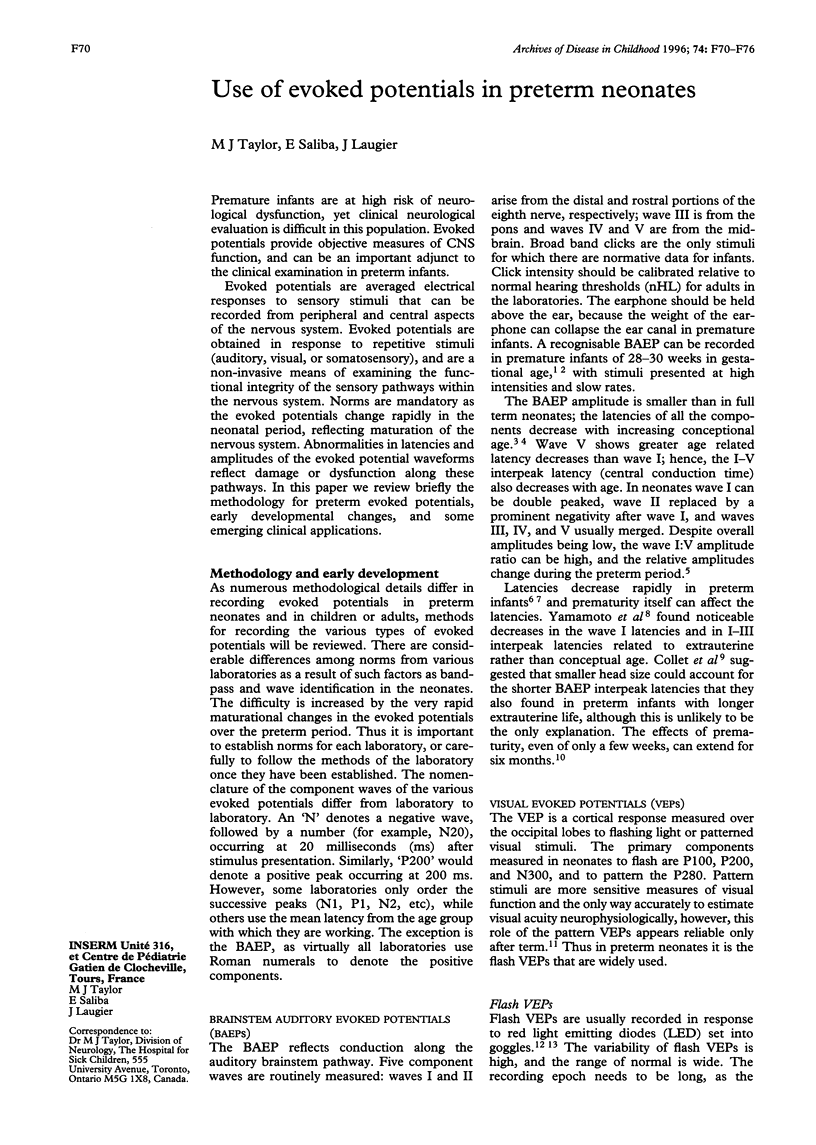
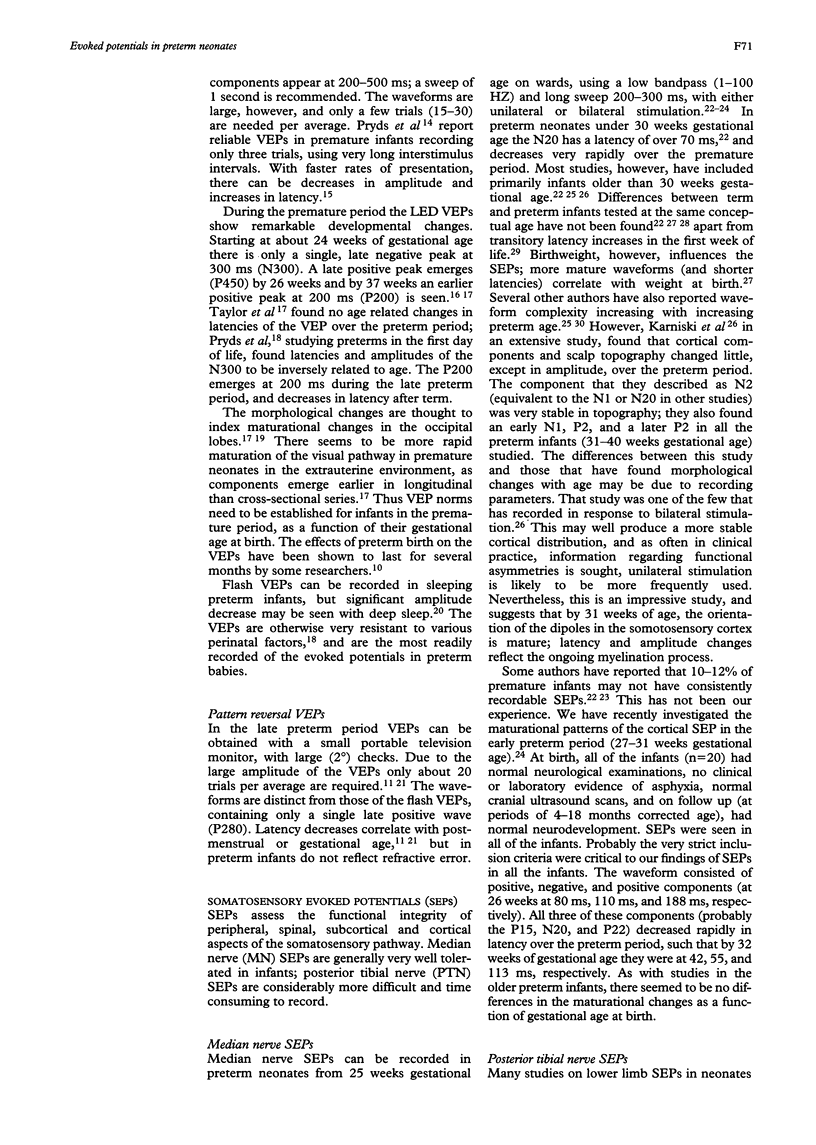
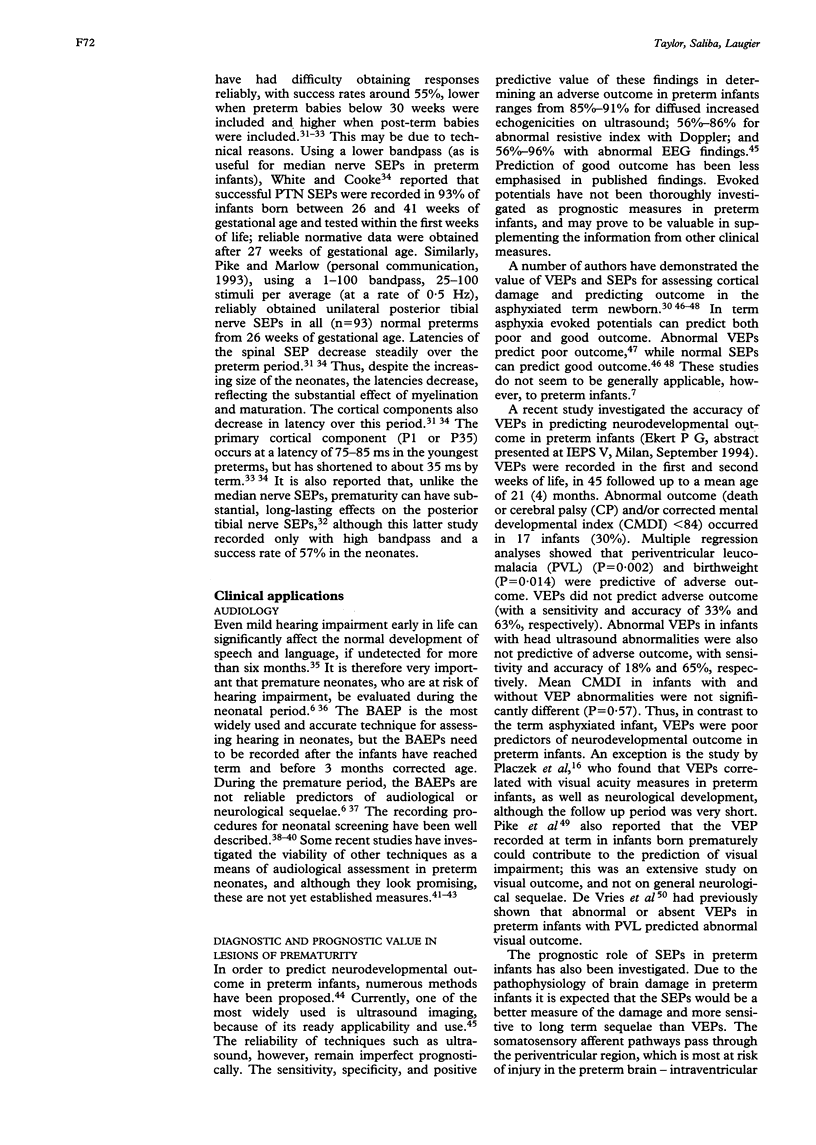
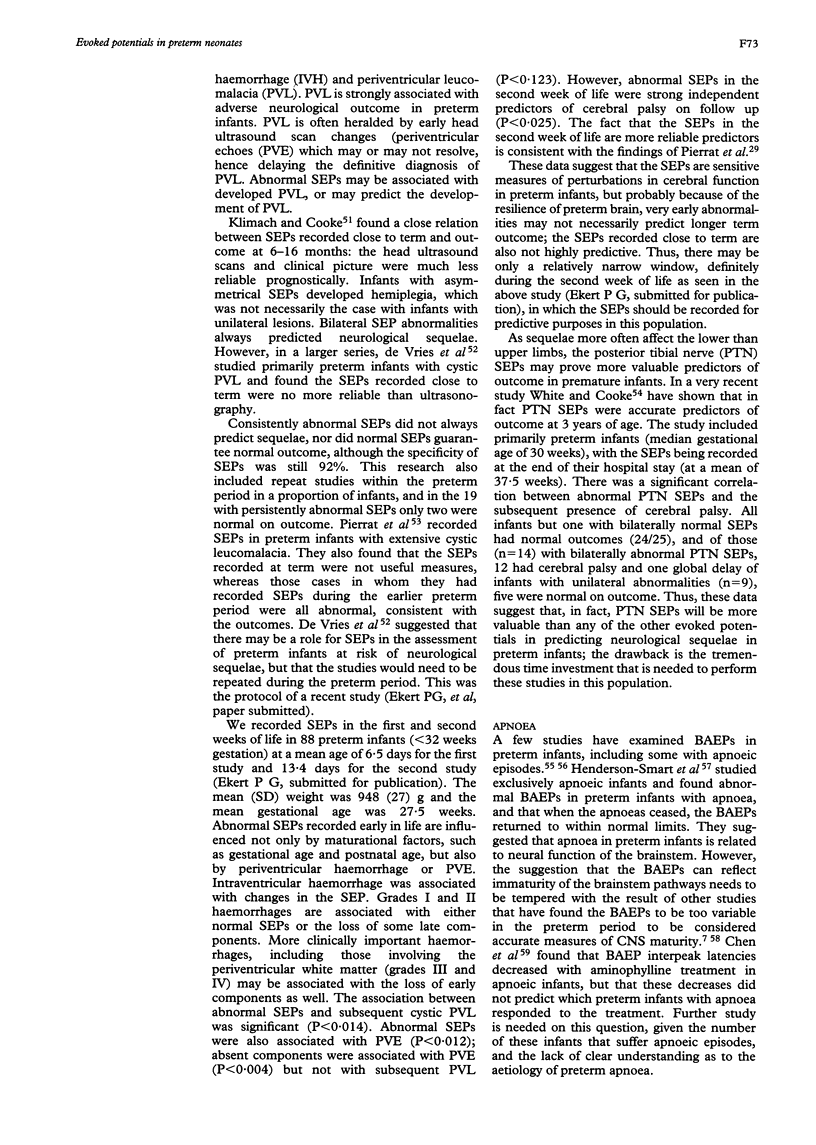
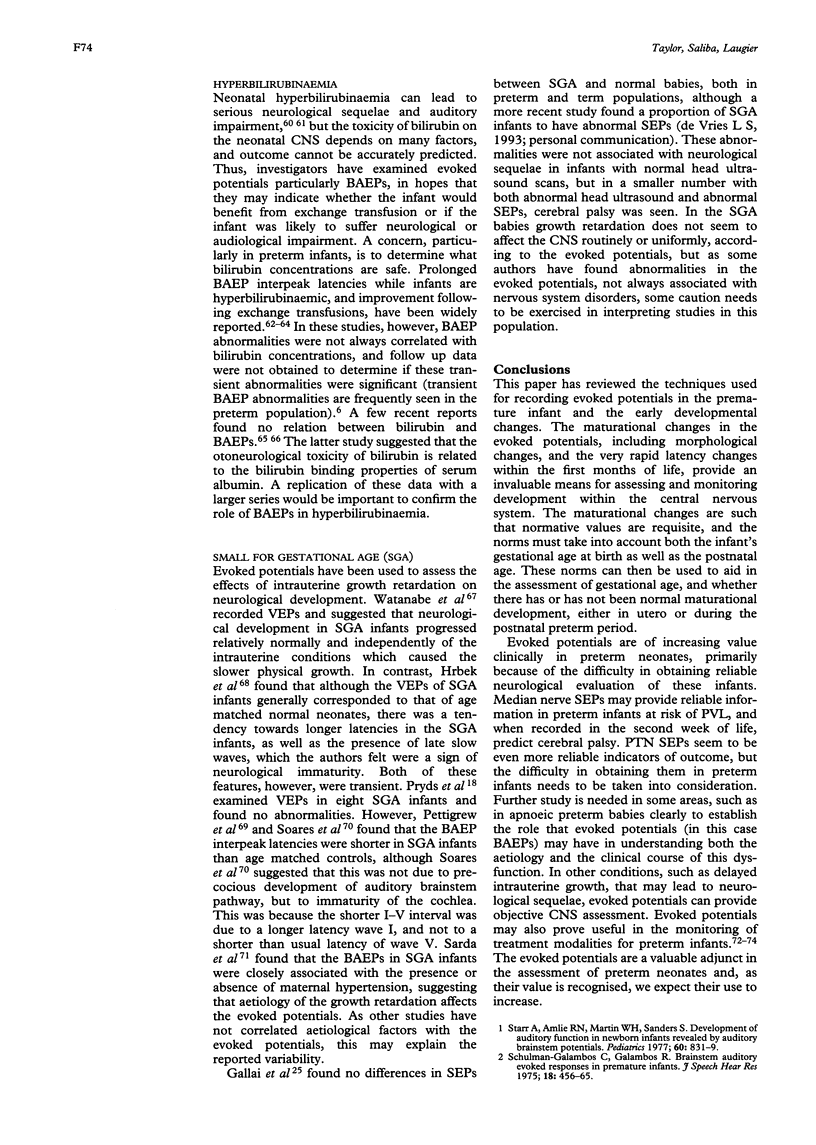
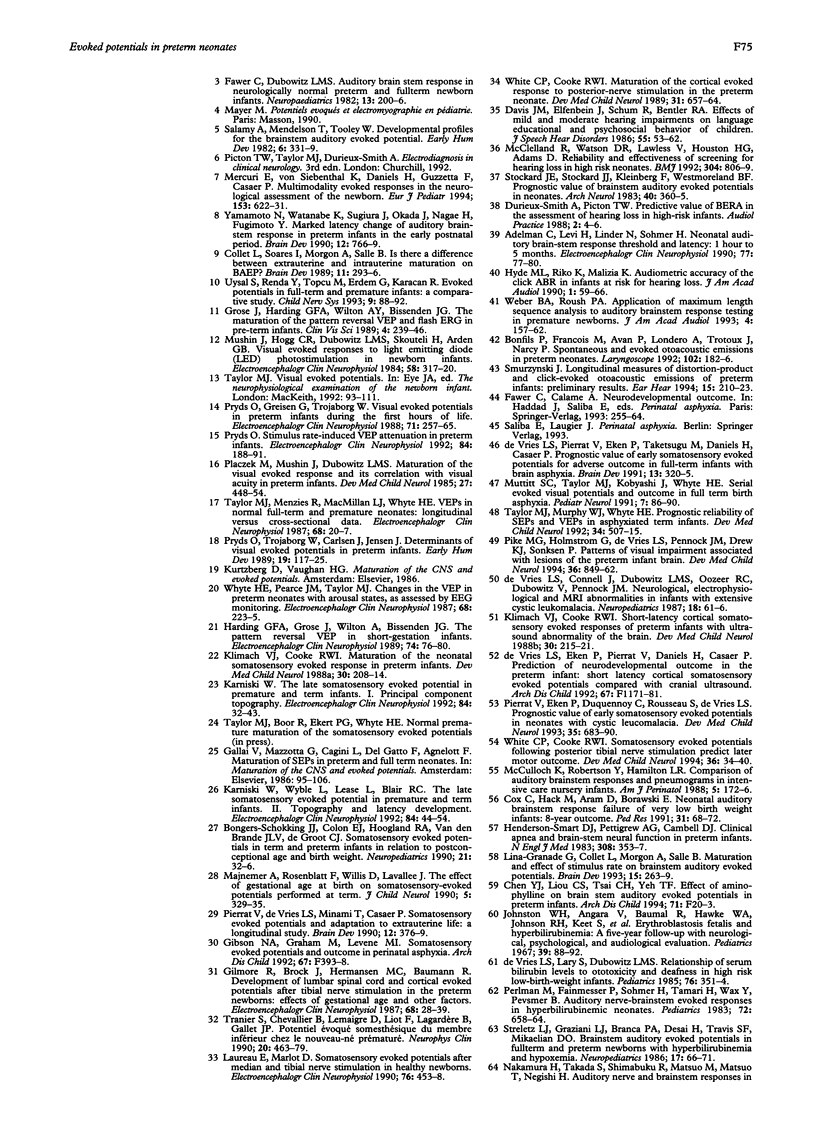

Selected References
These references are in PubMed. This may not be the complete list of references from this article.
- Adelman C., Levi H., Linder N., Sohmer H. Neonatal auditory brain-stem response threshold and latency: 1 hour to 5 months. Electroencephalogr Clin Neurophysiol. 1990 Jan-Feb;77(1):77–80. doi: 10.1016/0168-5597(90)90019-a. [DOI] [PubMed] [Google Scholar]
- Bonfils P., Francois M., Avan P., Londero A., Trotoux J., Narcy P. Spontaneous and evoked otoacoustic emissions in preterm neonates. Laryngoscope. 1992 Feb;102(2):182–186. doi: 10.1288/00005537-199202000-00014. [DOI] [PubMed] [Google Scholar]
- Bongers-Schokking J. J., Colon E. J., Hoogland R. A., Van den Brande J. L., de Groot C. J. Somatosensory evoked potentials in term and preterm infants in relation to postconceptional age and birth weight. Neuropediatrics. 1990 Feb;21(1):32–36. doi: 10.1055/s-2008-1071454. [DOI] [PubMed] [Google Scholar]
- Chen Y. J., Liou C. S., Tsai C. H., Yeh T. F. Effect of aminophylline on brain stem auditory evoked potentials in preterm infants. Arch Dis Child Fetal Neonatal Ed. 1994 Jul;71(1):F20–F23. doi: 10.1136/fn.71.1.f20. [DOI] [PMC free article] [PubMed] [Google Scholar]
- Collet L., Soares I., Morgon A., Salle B. Is there a difference between extrauterine and intrauterine maturation on BAEP? Brain Dev. 1989;11(5):293–296. doi: 10.1016/s0387-7604(89)80055-5. [DOI] [PubMed] [Google Scholar]
- Davis J. M., Elfenbein J., Schum R., Bentler R. A. Effects of mild and moderate hearing impairments on language, educational, and psychosocial behavior of children. J Speech Hear Disord. 1986 Feb;51(1):53–62. doi: 10.1044/jshd.5101.53. [DOI] [PubMed] [Google Scholar]
- De Vries L. S., Connell J. A., Dubowitz L. M., Oozeer R. C., Dubowitz V., Pennock J. M. Neurological, electrophysiological and MRI abnormalities in infants with extensive cystic leukomalacia. Neuropediatrics. 1987 May;18(2):61–66. doi: 10.1055/s-2008-1052453. [DOI] [PubMed] [Google Scholar]
- De Vries L. S., Pierrat V., Eken P., Minami T., Daniels H., Casaer P. Prognostic value of early somatosensory evoked potentials for adverse outcome in full-term infants with birth asphyxia. Brain Dev. 1991 Sep;13(5):320–325. doi: 10.1016/s0387-7604(12)80126-4. [DOI] [PubMed] [Google Scholar]
- Esbjörner E., Larsson P., Leissner P., Wranne L. The serum reserve albumin concentration for monoacetyldiaminodiphenyl sulphone and auditory evoked responses during neonatal hyperbilirubinaemia. Acta Paediatr Scand. 1991 Apr;80(4):406–412. doi: 10.1111/j.1651-2227.1991.tb11874.x. [DOI] [PubMed] [Google Scholar]
- Fawer C. L., Dubowitz L. M. Auditory brain stem response in neurologically normal preterm and full-term newborn infants. Neuropediatrics. 1982 Nov;13(4):200–206. doi: 10.1055/s-2008-1059623. [DOI] [PubMed] [Google Scholar]
- Friss H. E., Wavrek D., Martin W. H., Wolfson M. R. Brain-stem auditory evoked responses to hypercarbia in preterm infants. Electroencephalogr Clin Neurophysiol. 1994 May;90(5):331–336. doi: 10.1016/0013-4694(94)90049-3. [DOI] [PubMed] [Google Scholar]
- Gilmore R., Brock J., Hermansen M. C., Baumann R. Development of lumbar spinal cord and cortical evoked potentials after tibial nerve stimulation in the pre-term newborns: effects of gestational age and other factors. Electroencephalogr Clin Neurophysiol. 1987 Jan;68(1):28–39. doi: 10.1016/0168-5597(87)90067-0. [DOI] [PubMed] [Google Scholar]
- Harding G. F., Grose J., Wilton A., Bissenden J. G. The pattern reversal VEP in short-gestation infants. Electroencephalogr Clin Neurophysiol. 1989 Jan-Feb;74(1):76–80. doi: 10.1016/0168-5597(89)90053-1. [DOI] [PubMed] [Google Scholar]
- Henderson-Smart D. J., Pettigrew A. G., Campbell D. J. Clinical apnea and brain-stem neural function in preterm infants. N Engl J Med. 1983 Feb 17;308(7):353–357. doi: 10.1056/NEJM198302173080702. [DOI] [PubMed] [Google Scholar]
- Hyde M. L., Riko K., Malizia K. Audiometric accuracy of the click ABR in infants at risk for hearing loss. J Am Acad Audiol. 1990 Apr;1(2):59–66. [PubMed] [Google Scholar]
- Johnston W. H., Angara V., Baumal R., Hawke W. A., Johnson R. H., Keet S., Wood M. Erythroblastosis fetalis and hyperbilirubinemia. A five-year follow-up with neurological, psychological, and audiological evaluation. Pediatrics. 1967 Jan;39(1):88–92. [PubMed] [Google Scholar]
- Karniski W. The late somatosensory evoked potential in premature and term infants. I. Principal component topography. Electroencephalogr Clin Neurophysiol. 1992 Jan-Feb;84(1):32–43. doi: 10.1016/0168-5597(92)90066-k. [DOI] [PubMed] [Google Scholar]
- Karniski W., Wyble L., Lease L., Blair R. C. The late somatosensory evoked potential in premature and term infants. II. Topography and latency development. Electroencephalogr Clin Neurophysiol. 1992 Jan-Feb;84(1):44–54. doi: 10.1016/0168-5597(92)90067-l. [DOI] [PubMed] [Google Scholar]
- Klimach V. J., Cooke R. W. Maturation of the neonatal somatosensory evoked response in preterm infants. Dev Med Child Neurol. 1988 Apr;30(2):208–214. doi: 10.1111/j.1469-8749.1988.tb04752.x. [DOI] [PubMed] [Google Scholar]
- Klimach V. J., Cooke R. W. Short-latency cortical somatosensory evoked responses of preterm infants with ultrasound abnormality of the brain. Dev Med Child Neurol. 1988 Apr;30(2):215–221. doi: 10.1111/j.1469-8749.1988.tb04753.x. [DOI] [PubMed] [Google Scholar]
- Laureau E., Marlot D. Somatosensory evoked potentials after median and tibial nerve stimulation in healthy newborns. Electroencephalogr Clin Neurophysiol. 1990 Nov;76(5):453–458. doi: 10.1016/0013-4694(90)90098-5. [DOI] [PubMed] [Google Scholar]
- Lina-Granade G., Collet L., Morgon A., Salle B. Maturation and effect of stimulus rate on brainstem auditory evoked potentials. Brain Dev. 1993 Jul-Aug;15(4):263–269. doi: 10.1016/0387-7604(93)90021-y. [DOI] [PubMed] [Google Scholar]
- Majnemer A., Rosenblatt B., Willis D., Lavallee J. The effect of gestational age at birth on somatosensory-evoked potentials performed at term. J Child Neurol. 1990 Oct;5(4):329–335. doi: 10.1177/088307389000500412. [DOI] [PubMed] [Google Scholar]
- McClelland R. J., Watson D. R., Lawless V., Houston H. G., Adams D. Reliability and effectiveness of screening for hearing loss in high risk neonates. BMJ. 1992 Mar 28;304(6830):806–809. doi: 10.1136/bmj.304.6830.806. [DOI] [PMC free article] [PubMed] [Google Scholar]
- McCulloch K., Roberson Y., Hamilton L. R. Comparison of auditory brainstem responses and pneumograms in intensive care nursery infants. Am J Perinatol. 1988 Apr;5(2):172–176. doi: 10.1055/s-2007-999680. [DOI] [PubMed] [Google Scholar]
- Mercuri E., von Siebenthal K., Daniëls H., Guzzetta F., Casaer P. Multimodality evoked responses in the neurological assessment of the newborn. Eur J Pediatr. 1994 Sep;153(9):622–631. doi: 10.1007/BF02190680. [DOI] [PubMed] [Google Scholar]
- Mushin J., Hogg C. R., Dubowitz L. M., Skouteli H., Arden G. B. Visual evoked responses to light emitting diode (LED) photostimulation in newborn infants. Electroencephalogr Clin Neurophysiol. 1984 Oct;58(4):317–320. doi: 10.1016/0013-4694(84)90056-7. [DOI] [PubMed] [Google Scholar]
- Muttitt S. C., Taylor M. J., Kobayashi J. S., MacMillan L., Whyte H. E. Serial visual evoked potentials and outcome in term birth asphyxia. Pediatr Neurol. 1991 Mar-Apr;7(2):86–90. doi: 10.1016/0887-8994(91)90002-3. [DOI] [PubMed] [Google Scholar]
- Nakamura H., Takada S., Shimabuku R., Matsuo M., Matsuo T., Negishi H. Auditory nerve and brainstem responses in newborn infants with hyperbilirubinemia. Pediatrics. 1985 Apr;75(4):703–708. [PubMed] [Google Scholar]
- Perlman M., Fainmesser P., Sohmer H., Tamari H., Wax Y., Pevsmer B. Auditory nerve-brainstem evoked responses in hyperbilirubinemic neonates. Pediatrics. 1983 Nov;72(5):658–664. [PubMed] [Google Scholar]
- Pettigrew A. G., Edwards D. A., Henderson-Smart D. J. The influence of intra-uterine growth retardation on brainstem development of preterm infants. Dev Med Child Neurol. 1985 Aug;27(4):467–472. doi: 10.1111/j.1469-8749.1985.tb04570.x. [DOI] [PubMed] [Google Scholar]
- Pierrat V., Eken P., Duquennoy C., Rousseau S., de Vries L. S. Prognostic value of early somatosensory evoked potentials in neonates with cystic leukomalacia. Dev Med Child Neurol. 1993 Aug;35(8):683–690. doi: 10.1111/j.1469-8749.1993.tb11713.x. [DOI] [PubMed] [Google Scholar]
- Pierrat V., de Vries L. S., Minami T., Casaer P. Somatosensory evoked potentials and adaptation to extrauterine life: a longitudinal study. Brain Dev. 1990;12(4):376–379. doi: 10.1016/s0387-7604(12)80068-4. [DOI] [PubMed] [Google Scholar]
- Pike M. G., Holmstrom G., de Vries L. S., Pennock J. M., Drew K. J., Sonksen P. M., Dubowitz L. M. Patterns of visual impairment associated with lesions of the preterm infant brain. Dev Med Child Neurol. 1994 Oct;36(10):849–862. doi: 10.1111/j.1469-8749.1994.tb11776.x. [DOI] [PubMed] [Google Scholar]
- Placzek M., Mushin J., Dubowitz L. M. Maturation of the visual evoked response and its correlation with visual acuity in preterm infants. Dev Med Child Neurol. 1985 Aug;27(4):448–454. doi: 10.1111/j.1469-8749.1985.tb04567.x. [DOI] [PubMed] [Google Scholar]
- Pryds O., Greisen G., Trojaborg W. Visual evoked potentials in preterm infants during the first hours of life. Electroencephalogr Clin Neurophysiol. 1988 Jul-Aug;71(4):257–265. doi: 10.1016/0168-5597(88)90025-1. [DOI] [PubMed] [Google Scholar]
- Pryds O., Schneider S. Aminophylline reduces cerebral blood flow in stable, preterm infants without affecting the visual evoked potential. Eur J Pediatr. 1991 Mar;150(5):366–369. doi: 10.1007/BF01955942. [DOI] [PubMed] [Google Scholar]
- Pryds O. Stimulus rate-induced VEP attenuation in preterm infants. Electroencephalogr Clin Neurophysiol. 1992 Mar-Apr;84(2):188–191. doi: 10.1016/0168-5597(92)90024-6. [DOI] [PubMed] [Google Scholar]
- Pryds O., Trojaborg W., Carlsen J., Jensen J. Determinants of visual evoked potentials in preterm infants. Early Hum Dev. 1989 May;19(2):117–125. doi: 10.1016/0378-3782(89)90122-9. [DOI] [PubMed] [Google Scholar]
- Salamy A., Mendelson T., Tooley W. H. Developmental profiles for the brainstem auditory evoked potential. Early Hum Dev. 1982 Sep;6(4):331–339. doi: 10.1016/0378-3782(82)90071-8. [DOI] [PubMed] [Google Scholar]
- Sarda P., Dupuy R. P., Boulot P., Rieu D. Brainstem conduction time abnormalities in small for gestational age infants. J Perinat Med. 1992;20(1):57–63. doi: 10.1515/jpme.1992.20.1.57. [DOI] [PubMed] [Google Scholar]
- Schulman-Galambos C., Galambos R. Brain stem auditory-evoked responses in premature infants. J Speech Hear Res. 1975 Sep;18(3):456–465. doi: 10.1044/jshr.1803.456. [DOI] [PubMed] [Google Scholar]
- Smurzynski J. Longitudinal measurements of distortion-product and click-evoked otoacoustic emissions of preterm infants: preliminary results. Ear Hear. 1994 Jun;15(3):210–223. doi: 10.1097/00003446-199406000-00002. [DOI] [PubMed] [Google Scholar]
- Soares I., Collet L., Delorme C., Salle B., Morgon A. Are click-evoked BAEPs useful in case of neonate hyperbilirubinemia? Int J Pediatr Otorhinolaryngol. 1989 Jul;17(3):231–237. doi: 10.1016/0165-5876(89)90050-5. [DOI] [PubMed] [Google Scholar]
- Soares I., Collet L., Morgon A., Salle B. Effect of brainstem auditory evoked potential stimulus intensity variations in neonates of small for gestational age. Brain Dev. 1988;10(3):174–177. doi: 10.1016/s0387-7604(88)80023-8. [DOI] [PubMed] [Google Scholar]
- Starr A., Amlie R. N., Martin W. H., Sanders S. Development of auditory function in newborn infants revealed by auditory brainstem potentials. Pediatrics. 1977 Dec;60(6):831–839. [PubMed] [Google Scholar]
- Stockard J. E., Stockard J. J., Kleinberg F., Westmoreland B. F. Prognostic value of brainstem auditory evoked potentials in neonates. Arch Neurol. 1983 Jun;40(6):360–365. doi: 10.1001/archneur.1983.04050060060011. [DOI] [PubMed] [Google Scholar]
- Streletz L. J., Graziani L. J., Branca P. A., Desai H. J., Travis S. F., Mikaelian D. O. Brainstem auditory evoked potentials in fullterm and preterm newborns with hyperbilirubinemia and hypoxemia. Neuropediatrics. 1986 May;17(2):66–71. doi: 10.1055/s-2008-1052503. [DOI] [PubMed] [Google Scholar]
- Taylor M. J., Menzies R., MacMillan L. J., Whyte H. E. VEPs in normal full-term and premature neonates: longitudinal versus cross-sectional data. Electroencephalogr Clin Neurophysiol. 1987 Jan;68(1):20–27. doi: 10.1016/0168-5597(87)90066-9. [DOI] [PubMed] [Google Scholar]
- Taylor M. J., Murphy W. J., Whyte H. E. Prognostic reliability of somatosensory and visual evoked potentials of asphyxiated term infants. Dev Med Child Neurol. 1992 Jun;34(6):507–515. doi: 10.1111/j.1469-8749.1992.tb11471.x. [DOI] [PubMed] [Google Scholar]
- Tranier S., Chevallier B., Lemaigre D., Liot F., Lagardère B., Gallet J. P. Potentiel évoqué somesthésique du membre inférieur chez le nouveau-né prématuré. Neurophysiol Clin. 1990 Dec;20(6):463–479. doi: 10.1016/s0987-7053(05)80103-0. [DOI] [PubMed] [Google Scholar]
- Uysal S., Renda Y., Topçu M., Erdem G., Karacan R. Evoked potentials in full-term and premature infants: a comparative study. Childs Nerv Syst. 1993 Apr;9(2):88–92. doi: 10.1007/BF00305314. [DOI] [PubMed] [Google Scholar]
- Watanabe K., Iwase K., Hara K. Maturation of visual evoked responses in low-birthweight infants. Dev Med Child Neurol. 1972 Aug;14(4):425–435. doi: 10.1111/j.1469-8749.1972.tb02615.x. [DOI] [PubMed] [Google Scholar]
- Weber B. A., Roush P. A. Application of maximum length sequence analysis to auditory brainstem response testing of premature newborns. J Am Acad Audiol. 1993 May;4(3):157–162. [PubMed] [Google Scholar]
- White C. P., Cooke R. W. Maturation of the cortical evoked response to posterior-nerve stimulation in the preterm neonate. Dev Med Child Neurol. 1989 Oct;31(5):657–664. doi: 10.1111/j.1469-8749.1989.tb04052.x. [DOI] [PubMed] [Google Scholar]
- White C. P., Cooke R. W. Somatosensory evoked potentials following posterior tibial nerve stimulation predict later motor outcome. Dev Med Child Neurol. 1994 Jan;36(1):34–40. doi: 10.1111/j.1469-8749.1994.tb11763.x. [DOI] [PubMed] [Google Scholar]
- Whyte H. E., Pearce J. M., Taylor M. J. Changes in the VEP in preterm neonates with arousal states, as assessed by EEG monitoring. Electroencephalogr Clin Neurophysiol. 1987 May;68(3):223–225. doi: 10.1016/0168-5597(87)90030-x. [DOI] [PubMed] [Google Scholar]
- Yamamoto N., Watanabe K., Sugiura J., Okada J., Nagae H., Fujimoto Y. Marked latency change of auditory brainstem response in preterm infants in the early postnatal period. Brain Dev. 1990;12(6):766–769. doi: 10.1016/s0387-7604(12)80003-9. [DOI] [PubMed] [Google Scholar]
- de Vries L. S., Lary S., Dubowitz L. M. Relationship of serum bilirubin levels to ototoxicity and deafness in high-risk low-birth-weight infants. Pediatrics. 1985 Sep;76(3):351–354. [PubMed] [Google Scholar]
- de Zegher F., de Vries L., Pierrat V., Daniels H., Spitz B., Casaer P., Devlieger H., Eggermont E. Effect of prenatal betamethasone/thyrotropin releasing hormone treatment on somatosensory evoked potentials in preterm newborns. Pediatr Res. 1992 Aug;32(2):212–214. doi: 10.1203/00006450-199208000-00017. [DOI] [PubMed] [Google Scholar]


